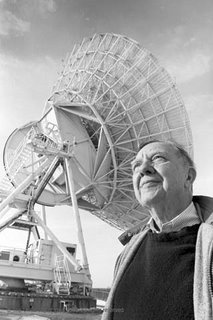James Van Allen (1914-2006)
 Photo by Tom Jorgensen. Courtsey: University of Iowa Office of University Relations.
Photo by Tom Jorgensen. Courtsey: University of Iowa Office of University Relations.Physicist James A Van Allen, a pioneer in space exploration who discovered the radiation belts surrounding the Earth that now bear his name died Wednesday morning, Aug. 9, 2006, of heart failure at University of Iowa Hospitals and Clinics. He was 91.
He was Regent Distinguished Professor of Physics in the University of Iowa College of Liberal Arts and Sciences.
Van Allen gained global attention in the late 1950s when instruments he designed and placed aboard the first US satellite, Explorer I, discovered the bands of intense radiation that surround the earth. The bands, later named in his honor, spawned a new field of research known as magnetospheric physics, an area of study that now involves more than 1000 investigators in more than 20 countries.
The discovery propelled the United States in its space exploration race with the Soviet Union and prompted Time magazine to put Van Allen on the cover of its May 4, 1959, issue. Among the other accomplishments of which he was most proud was his 1973 first-ever survey of the radiation belts of Jupiter using the Pioneer 10 spacecraft and his 1979 discovery and survey of Saturn's radiation belts using data from the Pioneer 11 spacecraft.
Between 1949 and 1962 he was the leader of a number of scientific expeditions to study cosmic rays and the Earth’s magnetic field, using American ships, in the Central Pacific, the Gulf of Alaska, the Arctic, the Atlantic, Central Pacific, South Pacific and Antarctic areas. He pioneered the use of balloons, Aerobee rockets and the combination of the two, for the measurement of the intensity of cosmic rays at high altitudes. It was this work that led to his involvement in Explorer 1 and the discovery of the belts that bear his name.
Even though he retired from full-time teaching in 1985, Van Allen continued to monitor data gathered by other satellites and served as an interdisciplinary scientist for the Galileo spacecraft, which reached Jupiter in 1995.
Van Allen published more than 280 research papers in scientific journals and research monographs. He edited the book Scientific Uses of Earth Satellites (1958); co-authored Pioneer — First to Jupiter, Saturn and Beyond (1980); wrote Origins of Magnetospheric Physics (1983); wrote 924 Elementary Problems and Answers in Solar System (1993); and edited Cosmic Rays, The Sun and Geomagnetism: The Works of Scott E. Forbush (1993).
Labels: Physicist

0 Comments:
Post a Comment